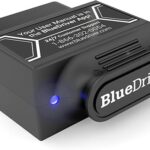Are you looking to enhance your vehicle’s fuel economy? In today’s market, where fuel costs are a significant concern for drivers, Obd2 Economy Chips have emerged as a popular option. These devices plug directly into your car’s OBD2 port and claim to boost your vehicle’s miles per gallon (MPG). But how do they work, and are they a worthwhile investment for fuel-conscious drivers? This article delves into the world of OBD2 economy chips, exploring their function, potential benefits, and what you need to know before installing one in your car.
What is an OBD2 Economy Chip?
An OBD2 economy chip, also known as a fuel-saving chip or performance chip, is an electronic device designed to optimize your car’s engine control unit (ECU) settings. It connects to your vehicle via the OBD2 port, a standard interface found in most modern cars. The primary goal of these chips is to reduce fuel consumption by making adjustments to engine parameters.
How Do OBD2 Economy Chips Work to Save Fuel?
These chips work by intercepting and modifying the signals between your car’s ECU and engine sensors. They typically focus on adjusting parameters like fuel injection timing, air-to-fuel ratio, and boost pressure (in turbocharged engines). By fine-tuning these settings based on data received from the ECU, the chip aims to create a more efficient combustion process. Manufacturers of OBD2 economy chips often claim that their devices can optimize fuel usage, leading to noticeable savings at the pump. The chip analyzes real-time data from your car’s computer to adapt and continuously refine these adjustments as you drive, theoretically maximizing fuel efficiency over time and adapting to your specific driving habits.
Potential Benefits of OBD2 Economy Chips
The advertised benefits of using an OBD2 economy chip often include:
- Improved Fuel Economy: The primary selling point is a reduction in fuel consumption, leading to more miles per gallon. Claims vary, but some manufacturers suggest savings of up to 15%.
- Easy Installation: OBD2 chips are designed for simple plug-and-play installation, requiring no mechanical expertise. Users can typically install them within minutes by locating the OBD2 port and plugging in the device.
- No Permanent Modifications: These chips are generally non-invasive and do not permanently alter your car’s ECU settings. Removing the chip reverts your vehicle back to its factory settings. This is a significant advantage for those concerned about warranty issues or long-term effects.
Are OBD2 Economy Chips Safe for Your Car?
Reputable OBD2 economy chips are designed to be safe for your vehicle when installed and used correctly. They are engineered not to cause damage to the engine or ECU. Since they do not involve permanent changes to the car’s software, they are generally considered a reversible modification. However, it’s crucial to choose chips from established brands and ensure compatibility with your specific car model to avoid potential issues. Always ensure the device is designed to work within the safe operating parameters of your engine.
Installing an OBD2 Economy Chip
Installation is typically straightforward:
- Locate the OBD2 Port: This port is usually found under the dashboard on the driver’s side.
- Plug in the Chip: With the ignition off, plug the OBD2 economy chip securely into the OBD2 port.
- Start Your Engine: Turn on the ignition and start your car. The chip will then begin communicating with your ECU and optimizing settings.
By understanding how OBD2 economy chips function and their potential benefits, you can make a more informed decision about whether they are the right solution to improve your vehicle’s fuel efficiency and save money on fuel costs.

